By Sue Kozel
NJ African American history resources for the American Revolution
By Sue Kozel, NJREA, retired faculty,
New Jersey universities and community colleges
Author’s note: When I first proposed writing this piece in the NJEA Review in early spring, George Floyd, Breonna Taylor, and others had not yet been murdered. Community leaders, citizens, clergy, and the Black Lives Matter movement pushed for racial justice and built broad coalitions of support. In late August, Jacob Blake was shot seven times in the back by police. Any article on New Jersey African American history resources during the American revolutionary period must note that Black Lives Mattered, whether acknowledged or not in historical records. This article lists many resources that can help 6-12 grade teachers and community college faculty engage students in discussions of freedom, enslavement, citizenship or the lack thereof, and the rights of Americans in pursuit of liberty during the American Revolutionary Era. Stay safe from COVID-19, and best wishes, Sue Kozel
Preparing for an inclusive semiquincentennial
The year 2026 will mark the 250th anniversary of New Jersey’s and our nation’s break from England to seek its independence. Sara Cureton, executive director of the New Jersey Historical Commission (NJHC), noted that there are many opportunities to continue collecting, sharing, building upon and developing new, inclusive resources, including the African American contributions, about New Jersey’s place in the revolutionary war story.
Many state organizations, including the New Jersey Historical Commission (NJHC), are leading efforts to showcase historical documents and stories that communicate New Jersey’s diverse history, including that of free African Americans, enslaved people, runaway slaves, the loyalists’ commitment to the king, and patriotic causes.
Nationally, the Philadelphia-based Museum of the American Revolution added important elements of New Jersey history to this year’s 100th anniversary of suffrage. Museum Director of Curatorial Affairs and Chief Historian Dr. Philip C. Mead shared documentation showing that three New Jersey African American men were found to have voted in the state before 1808—the year when Blacks were specifically excluded, along with women, from voting in the Garden State. The Black male voters from that era that have been found so far are Ephraim Hagerman, Tom Blue, and Caesar Trent, all of whom are documented to have voted in Montgomery Township in 1801.
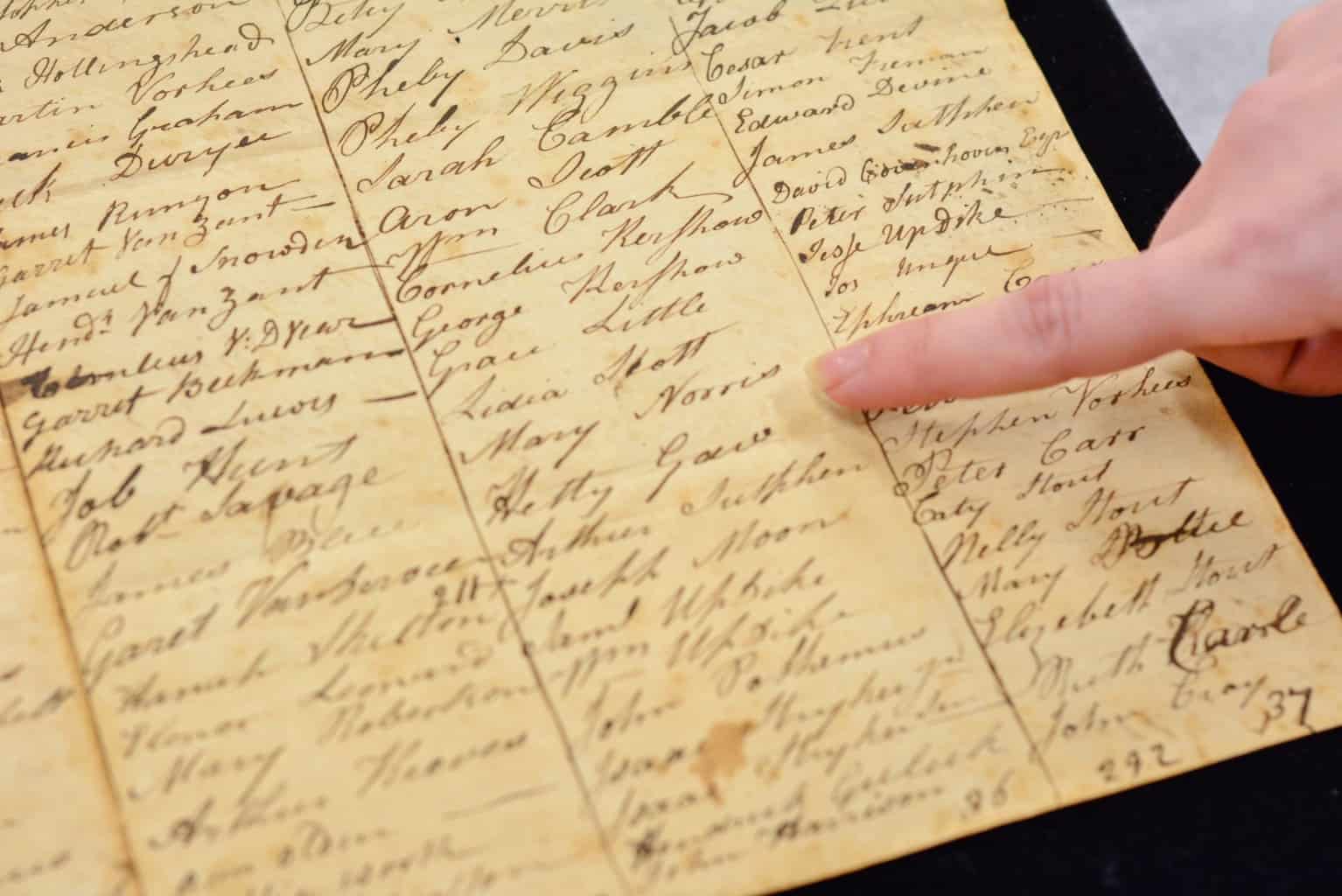
There are, in fact, far too many resources to fit into the print edition of the NJEA Review. For a longer version of this article containing many more resources, see its online version at njea.org/aaresourcesnj. All of this material can serve as preliminary and important resources to assist with the preparation for the semiquincentennial.
New Jersey is fortunate to have so many people dedicated to a protect, preserve, and present its rich and diverse history from the New Jersey Amistad Commission to the New Jersey State Archives, for example.
There are, in fact, far too many resources to fit into the print edition of the NJEA Review. For a longer version of this article containing many more resources, see its online version at njea.org/aaresourcesnj. All of this material can serve as preliminary and important resources to assist with the preparation for the semiquincentennial.
NJEA Convention workshop
Even this list of resources is only starting point. On Friday, Nov. 6, at 9 a.m., please join my online workshop at the virtual NJEA Convention titled, Engage, Inspire, Research, Teach: Early New Jersey Black History/American Revolution Resources. I will discuss more about the resources.

New Jersey State Archives
Petitions opposing and supporting emancipation
Sometimes petitions or documents submitted from citizens to advocate for one position or another, in this case either keeping enslavement or granting freedom, give us insight into how New Jerseyans thought about slavery. To help us begin, we will turn to the New Jersey State Archives.
The New Jersey State Archives has extraordinary resources available to help teach African American history. These petitions show us how contested the idea of freedom was for enslaved African Americans, and how many residents of cities and towns submitted petitions against and for the freedom of enslaved people on the eve of the American Revolution. A special thank you for allowing these resources to be digitized for this issue of NJEA Review.
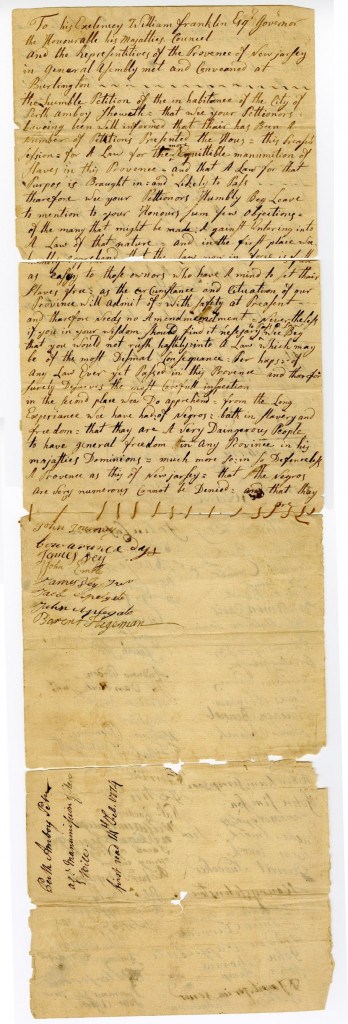
Source: From Collection: Department of Education, Bureau of Archives and History Manuscript Collection, SEDSL006, Box 24
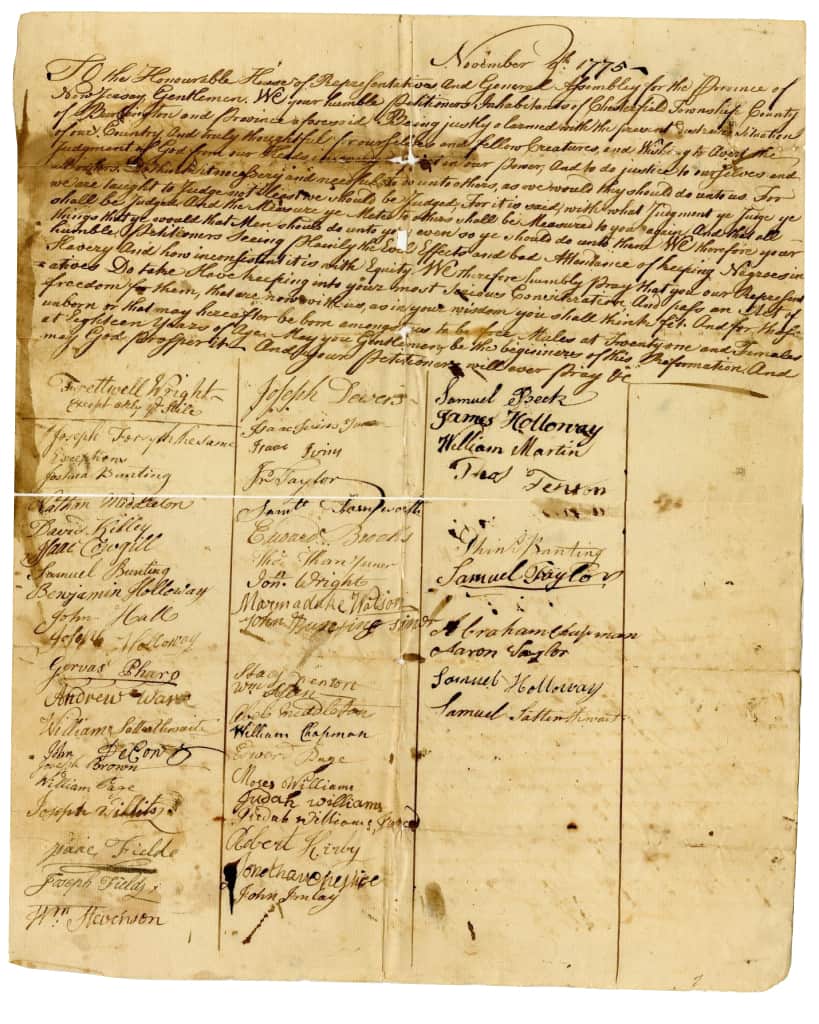
Source: From Collection: Department of Education, Bureau of Archives and History Manuscript Collection, SEDSL006, Box 24
Manumission records and birth certificates of children of enslaved persons
The state archives also include manumission records for several counties on microfilm, but this link, nj.gov/state/archives/chncl003.html, provides for Hunterdon County Slave Manumissions with scanned images. In this historical record New Jersey residents can search for family members. There is an index of names and the actual records scanned.
Additionally, there are Hunterdon County Birth Certificates of Children of Slaves, 1804-1835, at nj.gov/state/archives/chncl004.html. These include scanned images, so you can see the name of the slave holder and the name of the enslaved woman who gave birth. These records are significant because of New Jersey’s gradual emancipation law that freed children born into slavery from 1804 on after a certain age. Many counties are listed with finding aids, but most information is on microfilm at this time. You can search the archives at bit.ly/archivescatalognj. Search “slavery” under the subject search.
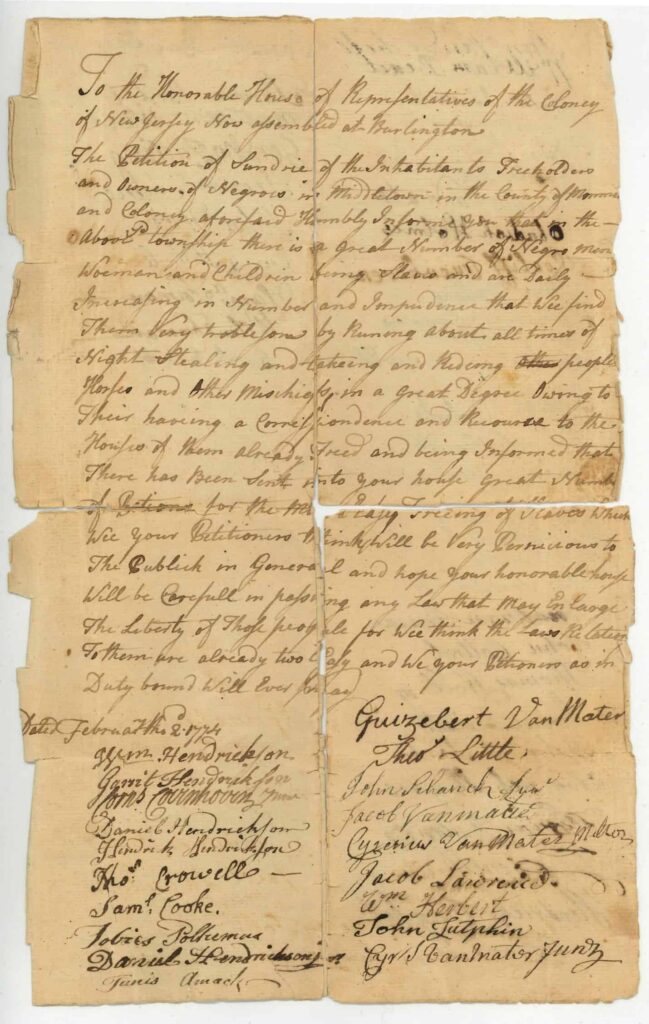
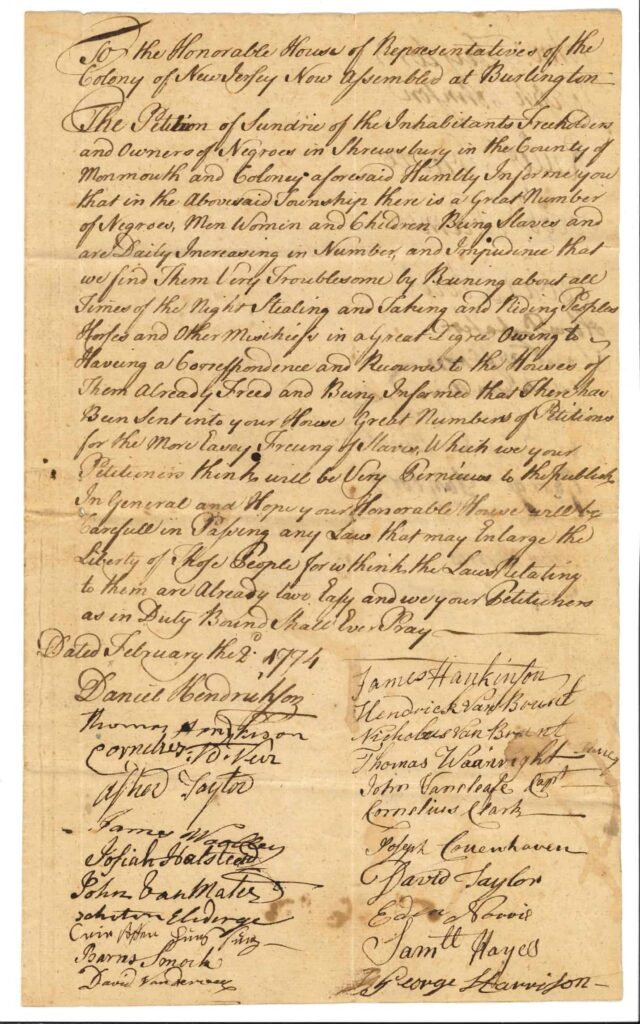
Source: From Collection: Department of Education, Bureau of Archives and History Manuscript Collection, SEDSL006, Box 24
New Jersey Historical Commission
Taking the lead on presenting an inclusive and diverse history of the American Revolution as part of the 250th Anniversary of our nation’s founding, many older New Jersey Historical Commission resources are available for free in the New Jersey State Library (see listing to follow).
One important starting point is the agency’s list of resources to mark the British history of slavery in the North America in 1619, and teachers might start with this source for background at bit.ly/slavehistorynjhc.
New Jersey Amistad Commission
Tasked with providing support and training for New Jersey school districts on the “infusion of African American content, and instructional materials and resources” for K-12 curriculum since 2002, the New Jersey Amistad Commission serves a critical partner in New Jersey’s teaching of African American history. In August, this commission sponsored another Summer Institute to help faculty access impressive resources for learning.
After visiting its main website, nj.gov/education/amistad faculty can register at njamistadcurriculum.net to access web-based curriculum resources including lesson plans and supplemental primary documents and other resources.
Unit 4, “The Emerging Atlantic World: Native Americans, Africans, and Europeans” and Unit 5 “Establishment of a New Nation and Independence to Republic” have extensive online resources built around New Jersey Student Learning Standards for Social Studies. No wheel has to be recreated here because of the depth of thoughtful content. Within Unit 5, for example there is a chronology of events from 1607 to 1792 that highlights key moments from the introduction of slavery to the British Colonies in North America to rebellions against slavery.
New Jersey State Library Resources
New Jersey State Librarian Deb Mercer provided some great suggestions for resources that can be used effectively in the classroom and are available online on the New Jersey State Library website.
The New Jersey African American Curriculum Guide
The 1997 publication of this guide by Larry Greene and Lenworth Gunther was published through the New Jersey Historical Commission. You can find links to each section of the guide at bit.ly/njlibraryaacurric.
In Unit 4, there is a link titled “Petition of Prime for Manumission (1786).” It pertains to an enslaved person named Prime Sheweth, who was freed after the revolution ended.
New Jersey’s Revolutionary Experience
This is a collection of 28 pamphlets, lesson plans, and teacher resources on New Jersey during the revolution found at bit.ly/njlibraryrevex.
Item Number 14 in the link focuses on African Americans during the revolution. Visit this link and download all the PDFs to enhance your course work. They are older resources, but they are helpful while new writing is undertaken.
Historian Giles R. Wright
The late historian Giles R. Wright prepared thoughtful historical reports on the underground railroad as well as a mini-version of history in his book, Afro-Americans in New Jersey: A Short History. Trenton, NJ: New Jersey Historical Commission, 1989. While this link, bit.ly/njlibraryaahistory, will provide you all the chapters, pay particular attention to the section labeled “Colonial Period to 1790.”
Wright served as a leading authority on Underground Railroad sites and history in New Jersey. Steal Away, Steal Away: A Guide to The Underground Railroad in New Jersey is very useful as students learn about the transition in the African American experience post-American Revolution. It can be found at bit.ly/stealawaynj.
While outside of the revolutionary time period, Civil Rights in New Jersey, 1945-2020: Discrimination in Social Life, will provide useful to teachers and students looking at change over time, especially in light of the advocacy of the Black Lives Matter movement leadership on criminal justice reform. You’ll find it at libguides.njstatelib.org/discrimination/public.
The New Jersey Digital Legal Library
This bibliography of New Jersey case law, from the colonial to the Early American Republic, provides examples of laws passed to punish slaves, enable enslavement, provide from individual manumissions of slaves, pass slave code laws, and move toward gradual abolition. You’ll find The Law of Slavery in New Jersey: An Annotated Bibliography at njlegallib.rutgers.edu/slavery/bibliog.html. Paul Axel-Lute provided an exceptional service to scholars, lawyers, and community members with this listing.
For example, faculty can show individual court petitions and case decisions to students about why an enslaved man, woman, or child was freed, for example, with the record including the slave’s name, the date, the city/town, the county, the slave owner’s name, and the details of the decision.
Students can touch history with these cases. The 1790 case, State Against James Anderson, involved an enslaved young man named Silas whose mother was freed, but he continued in enslavement, an act that violated his natural right to liberty. From my own research and publication, I know that the Pennsylvania Abolition Society joined with Quaker Richard Waln to push for freedom for Silas. You can read the case at njlegallib.rutgers.edu/slavery/cases/C21.html.
There originally submitted version of this article contained far too many resources to fit into the print edition of the NJEA Review. For a longer version of this article containing many more resources, see its online version at njea.org/aaresourcesnj.
In addition to what appears on these pages, you’ll find these additional resources in the online version:
New Jersey Department of Environmental Protection
In 2009, the New Jersey Department of Environmental Protection sponsored a traveling exhibit “Oh Freedom! Blacks on the Battlefront and in the Aftermath of the American Revolutionary War in New Jersey. You can view some of the materials that were available at: https://njparksandforests.org/historic/oh_freedom/index.html.
This exhibit allows teachers and students to access important primary documents about runaway slaves, soldiers, General George Washington’s changing position on African American soldiers, Loyalist and runaway slave Col. Tye’s efforts to support the British, Lord Dunmore’s 1775 Proclamation and more. The website includes a form with information on how to request the exhibit for your school. See https://njparksandforests.org/historic/oh_freedom/fact_sheet1.pdf
Sankofa Collaborative
Formed in 2017, five key New Jersey-based organizations—1804 Consultants, Grounds For Sculpture, The New Jersey Historical Society, Stoutsburg Sourland African American Museum, and the William Trent House Museum—created a new organization, the Sankofa Collaborative. The organization seeks to help “present, interpret, and discuss” African American history in various venues, including New Jersey schools. Grants from the New Jersey Council for the Humanities and the NJHC help Sankofa bring its mission throughout the state. A wonderful list of resources for K-12 teachers waits for your use at https://sankofacollaborative.org/resources
Dr. Linda J. Epps, the President and CEO of 1804 Consultants, participates in this collaborative effort. She described why the African American history presents a critical window for New Jersey’s identity:
Slavery was systemically incorporated into the economic, social, and political culture of New Jersey from 1664 till the passage of the 13th amendment. Enslaved men and women fought side by side with the patriots (Cudjoe Banquante) and with the British (Colonel Tye) with the purpose of securing favor with their masters and even more important, for securing their freedom. The contributions of the enslaved were numerous and varied during the war but for the majority, their servitude was not recognized during and did not end at the conclusion of the war.
The time has finally come when we understand their bondage as a subject worthy of introspection. As we enter into this era of Black Lives Matter and the commemoration of the 250th anniversary of the United States of America, let us not forget those Black lives who served to create and define the richness that is New Jersey, one of the wealthiest states in the Union. It was Black Lives that helped achieve and maintain that wealth.
To learn more about the rich programming opportunities and information available, visit this page on the detailed website for Sankofa Collective, https://sankofacollaborative.org/contact-us
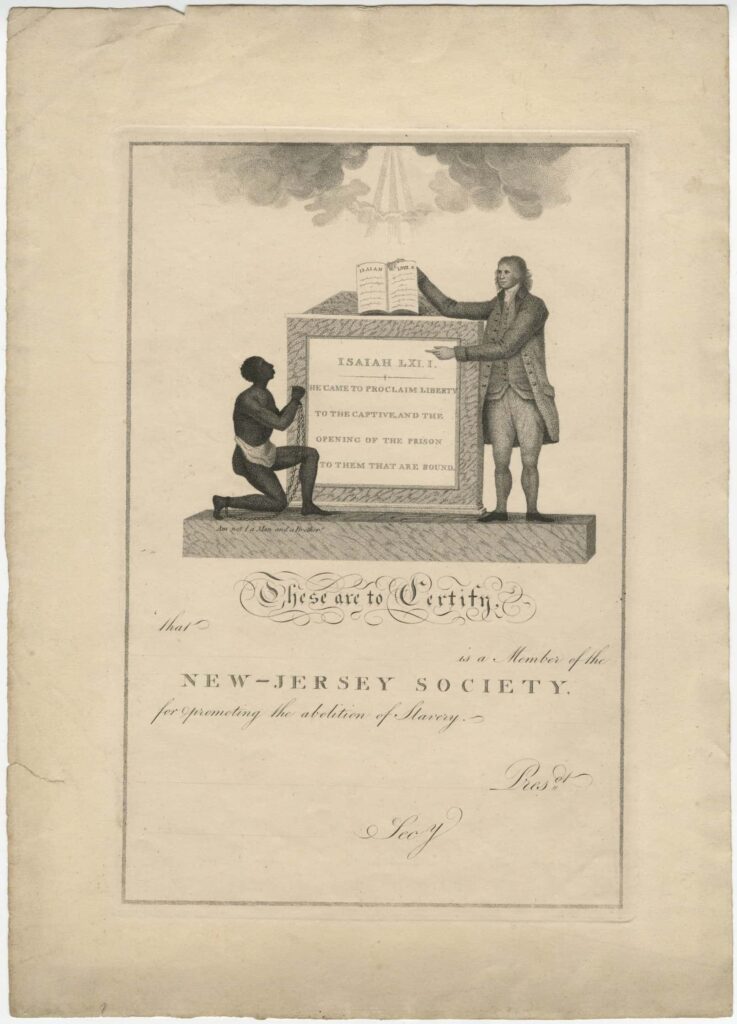
Haverford College Quaker and Special Collections
Thank you to Haverford College Quaker and Special Collections for granting permission to include two images and links for New Jersey African American history just following the Revolutionary War Era. Students and teachers will be able to trace the next steps in the resistance to slavery and the slow path to full emancipation. This link is for the Certificate for the New Jersey Society for the Promoting the Abolition of Slavery: https://triptych.brynmawr.edu/cdm/ref/collection/HC_QuakSlav/id/1563.
Additionally, Haverford welcomes teachers and students using their online resources on Quakers abolitionists, and this link is for the Minutes of the New Jersey Society for the Promoting the Abolition of Slavery Minutes 1793-1809. Students will be able to read the committees created, names of individuals serving from various New Jersey counties, and follow-up and compare this group’s abolitionist actions with the pace of new laws enacted in New Jersey or nationally. While this period is a bit after the Revolutionary era, students can able evaluate whether the contagion of liberty caught on as whites considered the rights of African Americans. https://triptych.brynmawr.edu/cdm/compoundobject/collection/HC_QuakSlav/id/12257/rec/1
Slave Voyages: Trans-Atlantic Slave Trade Database
The Slave Voyages website (https://slavevoyages.org/) provides visitors with a 3-D look at a slave ship, lesson plans on slavery, and a reservoir of resources to help teach the slave trade. A time lapse of the slave trade shows the movement of over 31,000 ships out of Africa to New World. https://slavevoyages.org/voyage/database#timelapse
Students and faculty might benefit from looking at the arrival of slave trade ships in ports of New Jersey or neighboring states. The Trans-Atlantic Slave Trade Database provides an outstanding collection of resources. For example, the below link lists slave ships that came to Perth Amboy, New Jersey from 1722 to 1761 with the number of slaves on board, the principal place of purchase origin, the ship captain, ship’s name, and year. A detailed record is available for each ship.
https://slavevoyages.org/american/database#searchId=8IvpuHFu
This list includes ship logs starting in Africa with many ports unspecified, but some listed as Cape Coast Castle, with detailed records listing Benin. Slaves were delivered to Philadelphia, Eastern New Jersey, and the dates range from 1686 to 1800. https://slavevoyages.org/voyage/database#searchId=4ZFniTbE
Lesson plans exist for grades 6-12, including one on how to research using the database. https://slavevoyages.org/resources/lessons#lesson-plans/researching-the-transatlantic-slave-trade/6/en/
University Resources for African Americans in this Era
The Princeton and Slavery Project
The Princeton and Slavery Project presents an outstanding community resource for citizens of all ages to understand the role the founders of Princeton University and subsequent leaders played in the perpetuation of slavery. Additionally, the website has resource links to help students understand the impact African Americans made on building Princeton University while slaves and being owned by men who professed to be advocates of liberty. https://slavery.princeton.edu/
For information to help high school teachers navigate the site and incorporate historical narratives into teaching, please see this link: https://slavery.princeton.edu/for-teachers/highschool
A lesson plan for slavery in a northern town allows students to think hard about slavery in a northern state in Princeton and includes primary documents of runaway slave ads for owners living in the town. https://slavery.princeton.edu/uploads/Unit-1-Slavery-in-a-Northern-Town-1.pdf
One example describes an enslaved woman named Lydia was sold in 1799 for $150 in South Brunswick, New Jersey. Students can see the actual bill of sale, and then click another link to see a full transcription of the bill and a deeper description of slaves owned by Princeton Chemistry Professor John McKean. An image of the inventory of his estate includes two additional slaves. Students can see how slave owners list slaves as property. https://slavery.princeton.edu/sources/bill-of-sale-for-lydia
Rutgers University Scarlet and Black Project
The Rutgers University Scarlet and Black Project sought to document the African American and Native American experiences at Rutgers, the State University. Three volumes of text presenting detailed documentation emerged to help New Jersey residents confront the historic dimensions of history often undocumented. https://scarletandblack.rutgers.edu/
In Scarlet and Black, Slavery and Dispossession in Rutgers History, Volume One, readers are introduced to nature of slavery and lack of freedom during the founding of this religious college and slave owners who were anti-abolitionists involved with Rutgers College. Recognized as a foremost historian on American enslavement and women in slavery, Distinguished Professor of History Deborah Gray White served as one of the editors.
https://www.rutgersuniversitypress.org/scarlet-and-black/9780813591520
https://www.scarletandblackproject.com/archive/items/browse?collection=5
Manumission of Sarah is presented as an example in 1802 of how some Rutgers slave owners granted freedom. This same slave owner, Andrew Kirkpatrick, also freed three other slaves, and gave permission for one to join the African American Association of New Brunswick. I did not know about this association, and the Rutgers site has a link to the African American Association, and students and teachers might find this confounding that African Americans needed permission from their owners to attend. https://www.scarletandblackproject.com/archive/collections/show/15
https://www.scarletandblackproject.com/archive/items/show/129
https://www.scarletandblackproject.com/archive/items/browse?tags=Andrew+Kirkpatrick+%281756-1831%29
A receipt issued to Colonel John Neilson recording the sale of an enslaved Black man who was taken from the enemy in war allows students to learn that African American slaves who were owned by Loyalists, the pro-British subjects, were often confiscated during the war and sold into slavery among patriots, another disturbing reality. https://www.scarletandblackproject.com/archive/items/show/107
Kean University – The World of William Livingston
Just developed late this summer, Kean University’s History Department has created a website dedicated to New Jersey’s William Livingston, who served during the American Revolution and as governor from 1776 until his death in 1790. This site, intended as a hub for archival resources related to Livingston and his world, also documents the history of slavery and the enslaved as it relates to Livingston, the home he built at Liberty Hall, and the Kean family who acquired Liberty Hall in the early 19th century. While much remains to be documented, Livingston claimed ownership of at least two enslaved persons whom he eventually freed. (https://revolutionarynj.org/rev-neighbors/william-livingston-2/#full-bio93c3-1499); The extended Livingston and Kean families also claimed ownership of enslaved persons.
In the section, “Teaching the History of Slavery and Enslaved Persons,” teachers and students will find various links to primary and secondary documents as well as teaching prompts about slavery in this Union County household. https://sites.google.com/kean.edu/williamlivingstonsworld/teaching-with-livingston/teaching-the-history-of-slavery-and-enslaved-persons?authuser=0
Using Monmouth County as an example for resources
Monmouth County, New Jersey was a battlefield for not only the Revolutionary War, but on the issue of slavery and freedom. Historians James Gigantino, Graham Russell Hodges, and others have written about these topics in their very important works.
Gigantino, James J. The Ragged Road to Abolition: Slavery and Freedom in New Jersey, 1775-1865. Philadelphia, PA: University of Pennsylvania Press, 2015.
Gigantino, James J. “The Curious Memory of Slavery in New Jersey, 1865-1941.” New Jersey Studies: An Interdisciplinary Journal 6, No. 1 (2020): 35–55.https://doi.org/10.14713/njs.v6i1.188.
Hodges. Graham Russell. Slavery and Freedom in the Rural North: African Americans in Monmouth County, New Jersey, 1665-1865. Oxford, England: Rowman and Littlefield Publishers, 1997.
Hodges, Graham Russell. Black New Jersey: 1664 to the Present Day. New Brunswick, NJ: Rutgers University Press, 2019.
I have also written on Monmouth County’s tradition of slavery and abolition, and my talk about the murder of an enslaved woman named “Wench Betty” by her slave owner in Upper Freehold, New Jersey in 1784 presents a chance to challenge how liberty that white Americans won in the revolution was denied to many NJ African Americans.
Kozel, Sue. “Why Wench Betty’s Story Matters – The Murder of a NJ Slave in 1784,” New Jersey Studies: An Interdisciplinary Journal [Online], Volume 6 Number 2 (9 July 2020). https://doi.org/10.14713/njs.v6i2.211https://njs.libraries.rutgers.edu/index.php/njs/article/view/211/268
For discussions about New Jersey freedom suits, that is manumission cases brought by New Jersey and Pennsylvania abolitionists before the New Jersey Supreme Court to free African Americans, see my other article:
https://njh.libraries.rutgers.edu/index.php/njh/article/view/1754
Kozel, Sue. “‘Testing “Liberty in New Jersey, 1775-1793: The Intersection of Slavery and Select Manumission Supreme Court Cases,” New Jersey History: Studies in State and Regional History [Online], Volume 127, Number 1 (2012) https://doi.org/10.14713/njh.v127i1.1754
Crossroads of the American Revolution, A National Heritage Area

The Crossroads of the American Revolution, A National Heritage Area serves as the not-for-profit partner to work with the NJHC to plan for the 250th anniversary of the founding of the United States in 2026. This organization keeps the public updated as to planning for the 250th anniversary.https://revolutionarynj.org/250th-updates/
On its website Crossroads produced “Revolutionary Neighbors,” a program supported by NJEA. For example, for Monmouth County, Col Tye is listed. He ran from his Quaker enslaver and joined the British Loyalist efforts, leading attacks on Monmouth County enslavers. https://revolutionarynj.org/rev-neighbors/colonel-tye-5/
Written by Michael Adelberg, the text describes how Tye led refugee attacks in Monmouth County with his Black Brigade, freeing the enslaved and taking prisoners. A short video is included, and students can “hear” history by the re-enactor portraying Tye, who fought in the Battle of Monmouth.
Larry A. Green and Lenworth Gunther dedicated Chapter 4 of The New Jersey African American Curriculum Guide, Grades 9 to 12 to the American Revolution. They included Col. Tye’s exploits in this chapter, which are available with the entire book, including lessons plans, through the New Jersey State Library link below.
For more information see: Adelberg, Michael. The American Revolution in Monmouth County: The Theatre of Spoil and Destruction. Charleston, SC: History Press, 2010.
Greene, Larry A. and Lenworth Gunther. The New Jersey African American Curriculum Guide, Grades 9 to 12. Trenton, NJ: New Jersey Department of State, NJ Historical Commission, 1997.
To learn more about Lord Dunmore’s proclamation that prompted enslaved men, including men in New Jersey, to run for freedom, you can read my blog for the American Philosophical Society based on records in the Thomas Jefferson Papers.
Kozel, Sue. “Turn the Other Page and Other Surprises from The Thomas Jefferson Papers.” Blog. APS Library. American Philosophical Society January 3, 2020. https://www.amphilsoc.org/blog/turn-page-and-other-surprises-thomas-jefferson-papers
Old Barracks Museum
The Old Barracks Museum in Trenton has a virtual program, for a fee, about an African American soldier fighting during the Revolutionary War. One of New Jersey’s most impactful historic sites, the staff works hard to provide free YouTube resources, with Facebook live sessions. In particular, “New Jersey in the slave economy” helps underscore the economic benefits the exploitation of slaves brought to New Jersey elites and white citizens. Hosted by Daryian Kelton and David Niescor, historic interpreters with the museum, provided a description Triangular Trade, key slave revenue generating crops, and crops from New Jersey that are sold in other slavery areas. Additionally, the video highlights slavery in Trenton, New Jersey. https://www.barracks.org/virtualfieldtrips.htmlhttps://www.facebook.com/oldbarracksmuseum/videos/vb.110676295637353/342978490078032/?type=2&theater
Daryian Kelton’s role as an African American interpreter of the American Revolution at the Old Barracks was featured in a video by “Beginner’s Guide to the 18th Century.” https://www.youtube.com/watch?v=kl6HJMnhMTw
Students might enjoy learning from a young African American man about how he is changing historical interpretation with his presence. Thank you to Kendall Kendrick for giving permission to make her video available as a resource for teachers. Kudos to Daryian, Janice Sellinger, Executive Director of the Crossroads for the American Revolution about the agencies planning efforts for the 250th Anniversary of the American Revolution, for being featured in a 2019 National Parks Service podcast on “Black Soldiers in the American Revolution.” Students and faculty will benefit from this important presentation as Daryian discusses his historical reenactor role as Col. Tye. https://www.nps.gov/subjects/heritageareas/nhapodcast2019.htm
A Sampling of other valuable resources from New Jersey
In closing, I thought I might share three additional sites out of the many available.
Hunterdon County
The writing of Beverly Mills Pennington and Sharon Elaine Buck has transformed our understanding of African American communities in Hunterdon County. Passionate about local history and trustees of the African America Stoutsburg Cemetery, these historians showcase segregation, the power of the African American church, and an extraordinary amount of local history. Their book, If These Stories Could Talk, African American Presence in the Hopewell Valley, Sourland Mountain, and Surrounding Regions of New Jersey, is a must read, and can help teachers and students recognize the power of individual researchers and how through tenacity and family history, they can uncover the past. They are two of the founders of the Stoutsburg Sourland African American Museum, and to learn more about this vibrant history and their publication, please visit https://www.ssaamuseum.org/ and https://www.ssaamuseum.org/book
Camden County
Historical Camden County produced a thoughtful, short video about Quakers and others who held African American slaves in the greater Camden County, New Jersey region and the Delaware River. When I have shown this eight-minute video to undergraduates, they are often surprised that slavery existed in colonial and early New Jersey. https://www.youtube.com/watch?v=djuuB9SZr2A&t=2s
Museum of the American Revolution
While not in New Jersey, the Philadelphia-based Museum of the American Revolution offers lesson plans and many resources on the American Revolution in general and some on New Jersey. Under the museum’s Finding Freedom initiative, several individual’s stories are highlighted, including Deborah, enslaved by George Washington, who chose to run away to the British during the war. Earlier in this story, the museum was mentioned as having unearthed the voting of three free African American men in 1801 in Montgomery Township, Somerset County, New Jersey. See this Washington Post story for more information, https://www.washingtonpost.com/graphics/2020/local/history/new-jersey-women-vote-1776-suffrage/
https://www.amrevmuseum.org/updates/stories/finding-freedom-deborah
The 21-page teacher guide include seven detailed lessons, with primary documents.
https://www.amrevmuseum.org/teacher-resource-guides
Thank you for considering these resources, and when we meet in the future, I hope to learn about your teaching and leadership.